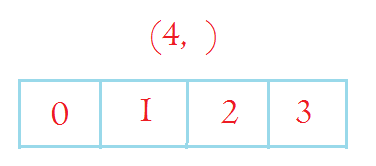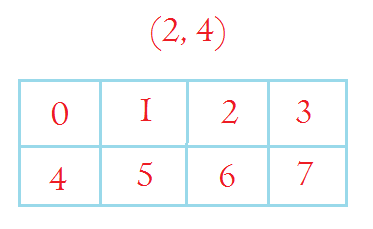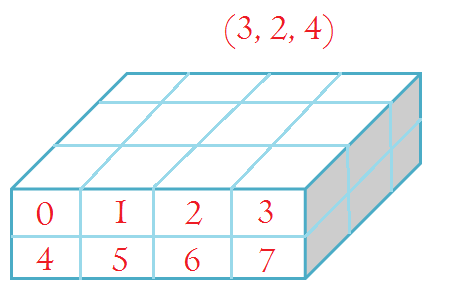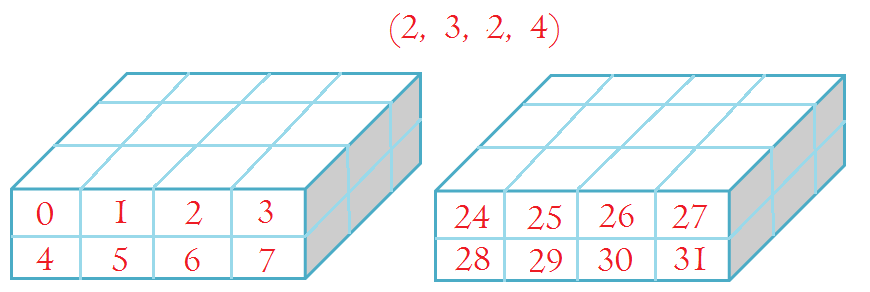0. Introduction
Continue to introduce a little about numpy following Numpy Introduction 01 and Numpy Introduction 02
- np.ndarray basics
- np.ndarray structure
- slicing, masking, fancy indexing and broadcasting
1. 矩阵的元素,维度和内存大小

import numpy as np
x= np.arange(2*3*2*4).reshape(2,3,2,4).astype('int32')
print("type of x is : " + str(type(x)))
type of x is : <type 'numpy.ndarray'>
# 不同的的dtype占用的内存大小不一样
print("dtype of x is : "+ str(x.dtype))
dtype of x is : int32
# x的维数,是一个4维的矩阵
print("x是一个4维矩阵,所以维度是: " + str(x.ndim))
x是一个4维矩阵,所以维度是: 4
#shape表示在每个维度上有多少个元素(item)
print("x是一个4维矩阵,每个维度上item的个数为: " + str(x.shape))
x是一个4维矩阵,每个维度上item的个数为: (2, 3, 2, 4)
# size表示总共有多少个元素(所有维度上shape的和)
print("x总共有多少个item: " + str(x.size) + ": = 2x3x2x4")
x总共有多少个item: 48: = 2x3x2x4
# 每一个item占用的内存的大小,int16是2bytes,int32是4bytes,float64是8bytes
print("每一个item占用的内存的大小: " + str(x.itemsize) + " bytes")
每一个item占用的内存的大小: 4 bytes
# np.ndarray所有item占用的总共内存
print("所有item占用的总共内存: " + str(x.nbytes) + " bytes")
所有item占用的总共内存: 192 bytes
print(x.strides)
(96, 32, 16, 4)
2. 矩阵的排列
numpy采用和C, java相似的方法:
-
首先横着排(列优先,所以任何时候列总是最后一个维度,即-1维总是列),np.arange(4)是一个行向量,占据4个列,shape为(4, ), shape[-1] = 4
-
增加一个维度以后变成2维的,增加的维度在shape上的表现是加在左边,在矩阵上的表现是增加了行.
np.arange(2*4).reshape(2,4)是一个2行4列的矩阵。每一行在内存里面是相连的 -
再增加一个维度以后变长3维的,增加的维度在shape上的表现是加在最左边,在矩阵上的表现是增加了depth.
np.arange(3*2*4).reshape(3, 2, 4)是depth为3,每个depth上是一个2行4列的矩阵 -
4d的时候,可以假想basic unit是3d的cube,然后把它们连成一行排起来,变成4d
-
同样,5d可以认为是在4d的基础上向下增加行,6d可以认为再增加depth,等等
总之:np.ndarray 的-1维度(最后一个维度)总是column,倒数第二个维度是行,倒数第三个维度是depth,
2.1. First will occupy columns(one dimension)

np.arange(4)
array([0, 1, 2, 3])
2.2. second will be row (down, two dimensions)

np.arange(8).reshape(2, 4)
array([[0, 1, 2, 3],
[4, 5, 6, 7]])
2.3. third will be depth direction (3 dimensions, 3 arrays each shape is 2x4)

np.arange(24).reshape(3, 2, 4)
array([[[ 0, 1, 2, 3],
[ 4, 5, 6, 7]],
[[ 8, 9, 10, 11],
[12, 13, 14, 15]],
[[16, 17, 18, 19],
[20, 21, 22, 23]]])
2. 4. forth will be column blocks, each block is 3 dimension arrays

np.arange(48).reshape(2, 3, 2, 4)
array([[[[ 0, 1, 2, 3],
[ 4, 5, 6, 7]],
[[ 8, 9, 10, 11],
[12, 13, 14, 15]],
[[16, 17, 18, 19],
[20, 21, 22, 23]]],
[[[24, 25, 26, 27],
[28, 29, 30, 31]],
[[32, 33, 34, 35],
[36, 37, 38, 39]],
[[40, 41, 42, 43],
[44, 45, 46, 47]]]])
3. Slicing, Masking, Fancy Indexing and Broadcasting
- slicing: like slicing in python list, e.g.
x[3:6]. Slicing is a reference, not a copy. - masking: use boolean array indexing, e.g.
x[x > 2] - fancy indexing: pass a list/array of indices,
x[[1,3,5]] - broadcasting: a set of rules for array calculation with different dimension or shape size. broadcasting可以避免某些for循环,从而大大增加计算速度。
Broadcasting is a set of rules by which ufuncs operate on arrays of different sizes and/or dimensions.
Broadcasting rules: 1. 如果两个array的ndim不一样,那么会在ndim比较小的array左边垫上1(类似newaxis)直到两个array的ndim一样 2. 两个array在所有的dim上必须满足:要么在每一维度上size相同,要么size为1(size=1的array在其维度上会类似copy的方式把它展开到跟另一个矩阵相同size) 3. broadcasting得到的array的shape是原来两个矩阵在各个维度上的shape的最大值
3.1. An example of Broadcasting
使用broadcasting的一个例子,nearest neighbour: x0是一个100x3的矩阵,表示100个点,现在要求对这100个点里面的每一个给定的点,另外99个点里面哪个点跟这个给定的点欧氏距离最近。
np.random.seed(9)
x0 = np.random.normal(0, 1, 300).reshape(100, 3)
print(x0.shape)
(100, 3)
下面使用broadcasting来计算距离,这样可以避免for循环。
首先把100x3的矩阵reshape成100x1x3(e.g., x0.reshape(100, 1, 3)),变成一个depth为100,一行3列的矩阵。这个矩阵减去原来100行3列的矩阵,根据broadcasting的规则,它会这么做:
-
首先把ndim较小的矩阵在最左边增加一维,变成1x100x3,然后相减。这时候第一个矩阵在行上的size只有1,会被copy层成100(不是真正的copy,这儿只是借用copy这个说法),所以第一个矩阵变成100x100x3。同样第一个矩阵1x100x3,也会在它的depth上被copy100次变成100x100x3。
-
这样的结果就是初始的100x3的矩阵每一行都会跟这100x3的矩阵相减
-
最后得到的结果矩阵是100x100x3。
diff = x0.reshape(100, 1, 3) - x0
print(diff.shape)
(100, 100, 3)
distance = np.square(diff).sum(axis = -1)
i = np.arange(100)
distance[i, i] = np.inf
ind = np.argmin(distance, axis = 1)
print(ind[:10])
[73 22 11 21 21 71 28 28 41 31]
这样的结果跟sklearn的NearestNeighbors得到的结果相同:
from sklearn.neighbors import NearestNeighbors
dist_sk, ind_sk = NearestNeighbors().fit(x0).kneighbors(x0, 2)
print(ind_sk[:10, 1])
[73 22 11 21 21 71 28 28 41 31]
同样由上面我们也看到broadcasting的一个问题:大大增加了内存的使用。原来一个100x3的矩阵因为broadcasting,最后大小增加了100倍。如果矩阵的shape很大的时候,这样会消耗很多的内存。最后导致速度可能更慢而不是更快。